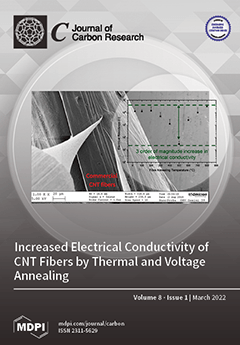Nanoporous carbon materials from biomass exhibit a high surface area due to well-defined pore structures. Therefore, they have been extensively used in separation and purification technologies as efficient adsorbents. Here, we report the iodine and methylene blue adsorption properties of the hierarchically porous
[...] Read more.
Nanoporous carbon materials from biomass exhibit a high surface area due to well-defined pore structures. Therefore, they have been extensively used in separation and purification technologies as efficient adsorbents. Here, we report the iodine and methylene blue adsorption properties of the hierarchically porous carbon materials prepared from
Areca catechu nut. The preparation method involves the phosphoric acid (H
3PO
4) activation of the
Areca catechu nut powder. The effects of carbonization conditions (mixing ratio with H
3PO
4, carbonization time, and carbonization temperature) on the textural properties and surface functional groups were studied. The optimum textural properties were obtained at a mixing ratio of 1:1, carbonized for 3 h at 400 °C, and the sample achieved a high specific surface area of 2132.1 m
2 g
−1 and a large pore volume of 3.426 cm
3 g
−1, respectively. The prepared materials have amorphous carbon structures and contain oxygenated surface functional groups. Due to the well-defined micro-and mesopore structures with the high surface area and large pore volume, the optimal sample showed excellent iodine and methylene blue adsorption. The iodine number and methylene blue values were ca. 888 mg g
−1 and 369 mg g
−1, respectively. The batch adsorption studies of methylene dye were affected by pH, adsorbent dose, contact time, and initial concentration. The optimum parameters for the methylene blue adsorption were in alkaline pH, adsorbent dose of 2.8 g L
−1, and contact time of 180 min. Equilibrium data could be best represented by the Langmuir isotherm model with a monolayer adsorption capacity of 333.3 mg g
−1. Thus, our results demonstrate that the
Areca catechu nut has considerable potential as the novel precursor material for the scalable production of high surface area hierarchically porous carbon materials that are essential in removing organic dyes from water.
Full article





